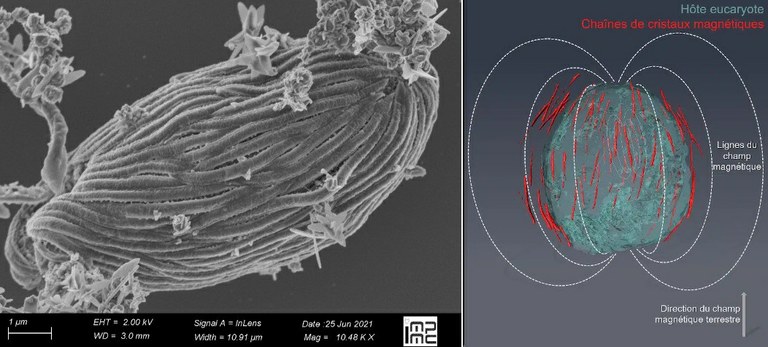Do you want to keep up to date? Subscribe to our newsletter. 1 mail every 2 months! |
 |

Left: Magnetotactic holobiont: the host is a unicellular eukaryote with magnetotactic bacteria on its surface. Right: Cryo transmission X-ray microscopy image (colored) obtained at MISTRAL beamline. Volume reconstruction of a magnetotactic holobiont shows chains of magnetic nanocrystals (in red) synthesized by the magnetic symbionts attached to the surface of their eukaryotic host (in cyan).
Cerdanyola del Vallès, 8th June 2023 Researchers from the Bioscience and Biotechnology Institute of Aix-Marseille (BIAM) have recently published a new work in the journal Proceedings of the National Academy of Science. The study reveals a singular association between magnetotactic bacteria and their host, a unicellular eukaryote (protist).
Magnetoreception is a function unique in the world of the living. Microorganisms are capable of perceiving and reacting to fluctuations in their environment: temperature, light, pressure, gravity, etc. The Earth’s magnetic field is also perceived by certain microorganisms: magnetotactic bacteria, whose mobility is guided by geomagnetic field lines. Magnetoreception guides their movement in aquatic sediments while locating more easily specific depths of the surface. In the microbial world, magnetoreception is based on the synthesis of intracellular chains of magnetic nanocrystals. It is currently the only form of geolocation to have been characterized by scientists.
All the microorganisms sensitive to the magnetic field described so far associate magnetoreception with sensory systems dedicated to certain physicochemical signals, thanks to which they can navigate towards or away from specific substances. This navigation behavior is called magnetotaxis and was, until recently, only observed in magnetotactic bacteria present in areas with strong chemical gradients such as aquatic sediments. By guiding their movement along vertical lines rather than in three-dimensions, their magnetism allows them to more easily find the zone where conditions are optimal for their growth. However, findings by researchers at the BIAM, revealed in 2019 that protists had also acquired this ability through a singular strategy. Some flagellated protists acquired magnetotaxis by associating with magnetotactic bacteria attached to their surface, becoming indispensable symbionts during evolution. This discovery, “revealed that magnetotaxis was performed collectively, with the eukaryotic host enabling swimming and perception of the chemical environment on one hand and the bacterial symbionts producing the nano-sized magnetic needles on the other. However, we did not yet uncover how these partners interacted from a physical point of view and how the magnetic properties are formed,” says Christopher Lefèvre, co-coordinator of the study.
When microbiology meets materials science and advanced imaging techniques
The study of living systems interactions at the microscopic scale would still be inaccessible without interdisciplinarity of scientists equipped with advanced scientific techniques. "Studying such an environmental biological system is difficult due to their size, low abundance and lack of models in culture, pushing technological limits," comments Daniel Chevrier, CNRS researcher at BIAM, first author and also co-coordinator of the study. Researchers had to deploy "an arsenal of approaches and technologies", including synchrotron-based X-ray microscopy at MISTRAL beamline of the ALBA Synchrotron.
"Thanks to these scientific and technological associations, we were able to demonstrate how symbiotic bacteria manage to optimize the displacement, ultrastructure and magnetic properties of their host, from the microscopic to the nanometric scale," says Chevrier. The authors were thus able to present in an explicit and detailed manner the membrane structures that ensure the longitudinal alignment of the cells with respect to each other. They also demonstrated that the magnetic properties of the biomineralized crystals maximize the magnetic moment of each symbiont and their host. "Surprisingly, these results showed us that geolocation was not the only benefit of making magnets, but that it was possible these nano-magnets could have a role in the physiology of microorganisms,” adds Lefèvre. “This is a good example of a cross-disciplinary project that highlights the importance of interdisciplinary approaches between materials science and imaging techniques to better understand the functioning of living organisms," concludes Caroline Monteil also co-coordinator of the study.
Text adapted from the original news by CNRS
Reference: Daniel M. Chevrier, Amélie Juhin, Nicolas Menguy, Romain Bolzoni, Paul E. D. Soto-Rodriguez, Mila Kojadinovic-Sirinelli, Greig A. Paterson, Rachid Belkhou, Wyn Williams, Fériel Skouri-Panet, Artemis Kosta, Hugo Le Guenno, Eva Pereiro, Damien Faivre, Karim Benzerara, Caroline L. Monteil, Christopher T.Lefevre. Collective magnetotaxis of microbial holobionts is optimized by the three-dimensional organization and magnetic properties of ectosymbionts. PNAS, Vol. 120, No. 10. doi/10.1073/pnas.2216975120
With the collaboration of Fundación Española para la Ciencia y la Tecnología. The ALBA Synchrotron is part of the of the Unidades de Cultura Científica y de la Innovación (UCC+i) of the FECYT and has received support through the FCT-21-17088 project.





